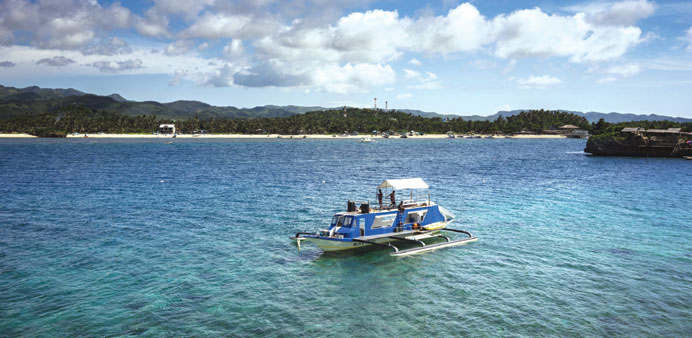A boat in the sea off Crystal Cove island in Boracay, the Philippines. The country, an archipelago of more than 7,000 tropical islands, has been quite successful in its efforts so far to lure in tourists from the Gulf, helped by increased airline capacity mainly to the Gulf Cooperation Council (GCC) region.
By Arno Maierbrugger
Gulf Times Correspondent
Bangkok
Both the Philippines and Indonesia are eager to attract more tourists from the Middle East to benefit from the usually higher spending patterns of Arab visitors, as well as from the business implication such visits could entail.
The Philippines have been quite successful in their efforts so far, helped by increased airline capacity mainly to the Gulf Cooperation Council (GCC) region. Qatar Airways added six flights a week from Doha to Manila in October this year, and Cebu Pacific also stepped up its weekly round trips. Etihad Airways will add three new weekly services between Abu Dhabi and Manila from May 2016, then offering a total of 17 return flights per week. Emirates is also very present on the route, saying that it will operate four more flights between Dubai and Manila beginning March 2016 on top of the twice-daily service it already has. This brings the total number of weekly flights operated by Emirates to the Philippines to 18.
So far this year, and also as a result of “Visit the Philippines Year 2015” campaign by the Philippine Department of Tourism (DoT) in the GCC, a total of 65,642 visitors from the Gulf visited the Philippines between January and September 2015, a 12% increase compared to 2014. Amongst those, the number from Saudi Arabia was highest with at 40,453 travellers, an increase of 17% compared to 2014.
Visitors from UAE were the next highest, followed by visitors from Kuwait.
According to Philippine Tourism Undersecretary Benito Bengzon Jr, Middle Eastern tourists are, alongside visitors from Russia, Europe, South Korea and Japan, the most welcome in term of spending. Visitors from these source markets were spending at least about $1,000 per person per visit in the Philippines, Bengzon said.
The DoT now has launched the “Visit the Philippines Again 2016” campaign, which will once more target potential Middle Eastern visitors. It is part of the strategy to reach a visitor number of 6mn in 2016, up from 5.2mn in 2015, and 10mn annually in the mid-term.
Indonesia has an even higher target, both in terms of Middle Eastern tourists and total visitors. The government in Jakarta aims at attracting no less than 20mn tourists in total by 2019, helped by its recently introduced visa waiver for 90 countries worldwide. Overall tourist arrivals to Indonesia in 2014 reached 9mn, with 261,000 tourists coming from the Middle East, up from 8.8man and 190,000 in 2013, respectively, whereby Saudis usually make the highest numbers of Mideast visitors to Indonesia. In 2015, the overall visitor number should come close to 10mn, and efforts to popularise halal tourism packages and other tailored holiday programmes for Muslims should help entice more visitors from the Middle East and particularly the GCC as the Indonesian Tourism Ministry has stepped up the number promotional event and trade missions in the region.
A new generous visa waiver should also help as it includes Saudi Arabia, Qatar and several other Middle Eastern countries.
The Philippines, in turn, also eased their visa policy especially for those who want to stay longer in the country. Visa-free entry for 30 days has been extended to new countries and tourist visa extensions for up to one year are now also possible without much of a hassle. The government also seeks to make it more attractive for foreign retirees to come to the Philippines and eventually settle down, especially as pensioners tend to buy property in a host country where they want to stay long-term. It has also been made comparably cheap to settle in the Philippines, cutting the amount retirees must keep in a local bank account to $20,000 from $75,000 and reduce the minimum age to qualify to just 35 years, which is among the most generous of such regulations in the world. In comparison, in Thailand, which is among the most popular global retirement destinations, the minimum deposit is $22,200 at current exchange rates, but the minimum age is 50 years.



